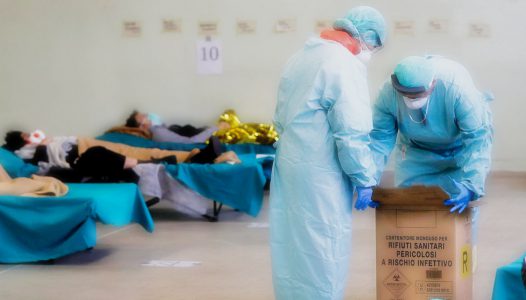by Massimo Balducci
The amount of resources to be mobilised by the EU Resilience and Recovery Fund (and connected funds) is huge. It is comparable with the amount of resources triggered off by the Marshall Plan after World War II. Compared with the GDP in some countries, the EU will invest more resources than the Marshall Plan did. In the case of Italy, the Marshall Plan invested about 12% of the Italian GDP. The EU will invest around 19% of the Italian GDP in Italy. Will the EU investment have an impact comparable with the one of the Marshall Plan? Or will it mostly be a positive impact and have negative unanticipated consequences that outweighs any positive outcome? Compliance shall possibly be called upon to play a key role to curb any negative unintended outcome. Here, the experience of the Marshall Plan can provide us with a useful frame of reference. A negative (i.e. what should be done differently in comparison to the Marshall Plan) point of reference and a positive one (i.e. what the EU should try to do following the Marshall Plan).
What should be done differently from the Marshall Plan? Actually, evaluation and supervision. With the Marshall Plan, rather with its management body established in Paris (the European Cooperation Administration), each supervision was carried out by a large number of supervisors (inspectors) who mingled professional evaluation standards with standards oriented by the political perspective of the winning power. Here, we should take advantage of the bulk of know how and skills the EU has been accumulating by developing and implementing its structural and cohesion funds. It should, however not be under-evaluated of the additional difficulty due to the fact that now the resources triggered off will be much larger than the resources involved by structural and cohesion funds. While resources devoted to structural and cohesion funds amount to about 30% of the EU yearly budget, the resources triggered off by the Resilience and Recovery Fund will amount to about 6 times of the EU yearly budget. Moreover, in the case of the Resilience and Recovery Fund, every Member State will be a beneficiary of the EU support, while with the structural and cohesion funds, only some Member States counted among the beneficiaries. Here, to avoid an opaque and silent, however deadly, war carried out in the intricacies of the Brussels bureaucracy and its comitology network, EU evaluation and compliance staff should be remarkably enlarged.
The Marshall Plan could prove, on the other hand, useful to provide us with suggestions as to what might/should be done to maximise the positive impact and minimise the negative outcome. Here, we will briefly analyse two useful components of the Marshall Plan: “capacity building” and “coordination”.
Capacity building
The Marshall Plan’s impact can be divided into two main components. On one side, we have resources made available to restart the economic processes that were damaged by war actions. Here, the issue is basically to re-establish the situation before the war. On the other side, the Marshall Plan did not confine its actions to merely re-establish the situation ex quo ante, but engaged deeply in the effort of developing a more advanced, more modernised, economic system. These actions are nowadays known as capacity building, an approach just developed in the framework of the Marshall Plan. Here, we will mention three main capacity building actions. First of all, we will mention the effort to develop a professional management not necessarily linked with company ownership, taking as point of reference the Sloan School of Management developed in the 30s at MIT. INSEAD, at Fontainbleau and the nowadays popular masters in business administration go back to this very capacity building policy of the Marshall Plan. It is here to be briefly remarked upon that in Germany, this policy proved to be a failure due to the fact that the co-management (Mitbestimmung) culture had already severed ownership from management. A second capacity building area of intervention is represented by the efforts to promote food supermarkets and large distribution of food. In Italy, the first chain of food supermarkets (Esselunga) was triggered off by the support for the Marshall Plan. Large no food distribution had actually originally started in Europe: Galeries La Favette, the Prix Unic chain in France and UPIM (Unico Prezzo Italiano Milano) in Italy. Large distribution had however never involved food. Here, the capacity building policy of the Marshall Plan had a “political” motivation as well: to compete with consumers’ cooperatives mostly managed by left wing unions. Capacity building policy was, moreover, oriented at the dissemination of the culture of working by processes by promoting the development and printing of operations manuals.
Coordination
Alfonso Zardi, formerly a top official in the arena of European Institutions, has recently pointed out to me that the European Cooperation Administration, i.e. the management staff of the Marshall Plan, engaged in a profound coordination effort. In a way, it sort of figured out a network of value chains that assured the mutually usefulness of the economic systems of the beneficiaries and the autonomy of the somehow integrated economies of the beneficiaries vis-à-vis the Comecon countries.
The “capacity building” policy and the “coordination” policy of the European Cooperation Administration were substantially based on the effort to disseminate the culture of working by processes as a tool to modernise the culture of hierarchy on which the pre war European economies were based.
The development of a professional management through a training process was a step forward compared with a management based on ownership. Large distribution is based on logistic processes. Coordination is achieved via a network of value chain processes. Operations manual are the elementary tool of management by processes.
The Resilience and Recovery Fund, like the Marshall Plan, is not only aiming at restarting the European economy after the stop caused by the Covid-19 pandemic, but it aims at improving the pre pandemic state of the art. The goals of the Resilience and Recovery Fund is to establish a green and digitalised economy. But, unlike the Marshall Plan, it does not have any room for “capacity building” and “coordination” policies. More specifically, there is no room for any effort whatsoever to promote the culture of processes as a step forward beyond the culture of hierarchy. Even though our economies are to be digitalised, they are firstly in need of all to be reengineered according to processes. To go green, our economies must not only replace foxily energy with renewable energy; they need to get better coordinated and streamlined, i.e. they need to be perceived and managed as a network of processes.
On the basis of my personal experience, I feel entitled to say that the culture of processes is not established in the Latin countries of Europe, not only in Italy and Spain, but in France as well. French public administration finds it difficult to actually implement any sort of analytical bookkeeping or cost accounting. This is simply because analytical bookkeeping requires well established and formalised work processes, which do not exist in the French administration, but are available in the German and Flemish administrations.
Not to mention the fact that for an effective compliance of the use of Recovery Fund resources, the culture of processes is mandatory.
The author, Massimo Balducci is a Professor at the University of Florence (Firenze) and one of the authors at our Italian website www.riskcompliance.it. He is an expert working for the European Network of Training Organizations of Local and Regional Authorities (ENTA). Massimo is an author of several publications in French, English and Italian about Public Management.







Pingback: Recovery Fund, riusciremo a usarlo? Le incognite secondo Balducci – ACQUA